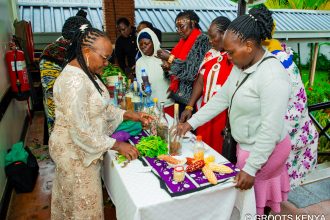By Henry Neondo
In the lush farmlands of Gitaru village of Molo, Nakuru County, a quiet revolution is taking place.
Farmers like Mr. Martin Kamau have discovered innovative ways to reduce household expenses but at the same time contribute to lessening the impact of human action on the environment and increase agricultural productivity of their farms.
With just three cows, Mr. Kamau has eliminated his reliance on electricity, paraffin, and charcoal for cooking, the usual fuel that his family and neighbours have used for years.
Kamau interacted with some organization he met in Egerton University, Njoro that he often visits in his day-to-day consultations on agronomy practices. He was taught that when he uses the waste from his livestock, he could generate biogas—a clean, renewable energy source—and produces organic fertilizer that enriches soil.
Kamau, without hesitation looked for money to purchase the needed biodigester kit, which consists of a biodigester, slurry agitation system, biogas piping and grill. The money needed was KES70,000. He sold some food stock, and borrowed some to put together the money that would help him buy the kit. The rest, as they say is history.
His story exemplifies how small-scale biogas technology can transform rural livelihoods while promoting environmental sustainability.
The Biogas Process
Biogas is produced through the anaerobic digestion of organic materials, such as animal dung, in a biogas digester. For Mr. Kamau, his three cows provide a steady supply of dung, which he collects daily. The dung is mixed with water to form a slurry and fed into the digester through the slurry agitation system. Once inside the biodigester, microorganisms break the slurry down in the absence of oxygen. This process produces methane gas, which is captured and stored for use as fuel through the biogas pipe.
The benefits do not end with the production of gas. According to Kamau, the byproduct of the process, commonly referred to as digestate, is an excellent organic fertilizer.
Rich in nutrients, it is used to nourish crops and improve soil health. This closed-loop system exemplifies circular agriculture, where waste is transformed into valuable resources.
Reducing Household Expenses
Before adopting biogas technology, Mr. Kamau spent a significant portion of his income on energy sources such as paraffin, charcoal, and electricity. These conventional fuels are not only expensive but also contribute to environmental degradation. Charcoal production, for example, is a leading cause of deforestation in Kenya.
By switching to biogas, Mr. Kamau no longer needs to purchase these fuels. The methane gas produced from his cows’ dung meets all his cooking needs, from boiling water to preparing meals. This has resulted in substantial savings, allowing him to allocate more resources toward other household and farm expenses.
According to Kamau, the environmental benefits of biogas are manifold. First, it provides a cleaner alternative to charcoal and paraffin, reducing greenhouse gas emissions and air pollution. “Burning biogas emits significantly less carbon dioxide and other harmful pollutants compared to traditional fuels,” he said.

Secondly, Kamau said that the biogas reduces deforestation by decreasing the demand for charcoal and firewood. In Nakuru, where trees are vital for maintaining ecological balance, this is a critical advantage. Forests play a crucial role in conserving biodiversity, regulating local climates, and preventing soil erosion.
He added that the organic fertilizer produced as a byproduct of biogas generation helps farmers like himself minimize the use of synthetic fertilizers and pesticides. These chemical inputs often contribute to soil degradation and water pollution. “I enrich the soil with digestate, which ends up growing healthier crops while preserving the integrity of the farm’s ecosystem,” he said.
“If the greenness and healthy-looking crops around Mr Kamau’s compound is testimony about the benefits of using biogas fertilizer, then without doubt, the use of this organic fertilizer has significantly improved Mr. Kamau’s agricultural output,” acknowledged Patrick Maina.
Maina said that unlike inorganic fertilizers, which provide a quick but short-lived nutrient boost, digestate enhances soil structure and fertility over time. It increases the soil’s ability to retain water and nutrients, making it particularly valuable in regions prone to drought.
The results are evident on Mr. Kamau’s farm, where his crops are thriving. He grows maize, vegetables, and fruit trees, all of which are healthier and more resilient to pests and diseases. This has not only increased his income from farming but also ensured a steady supply of nutritious food for his family.
While Mr. Kamau’s story highlights the potential of biogas technology, it also underscores the challenges that many farmers face in adopting it.
Initial Costs
Installing a biogas digester requires a significant upfront investment, which can be prohibitive for small-scale farmers. While the technology eventually pays for itself through energy savings and increased agricultural productivity, the initial cost remains a barrier.
Operating and maintaining a biogas system requires some level of technical expertise. Farmers need to be trained on how to manage the digester, monitor gas production, and use the digestate effectively. Without proper guidance, the system may not perform optimally.
Consistent biogas production depends on a steady supply of organic material. For farmers with fewer livestock, sourcing enough dung to feed the digester can be challenging. Take the example of Mr Karangathi Njoroge who has to buy dung from neighbours after every two days. He is lucky that the cattle owner does not have other competing biodigester owners to place high demand on his cow dung, otherwise, the cost would be prohibitive. Additionally, access to water for mixing the slurry may be limited in arid regions.
Many farmers are unaware of the benefits of biogas technology or lack information on how to access it. According to Mr Karangathi, advocacy and education campaigns are needed to raise awareness and demonstrate the technology’s potential.
To overcome these challenges and expand the adoption of biogas technology, a collaborative effort is required. Governments, NGOs, and private sector players must work together to make the technology more accessible and affordable.
Mr Karangathi noted that through Maendeleo Endelevu Action Program (MEAP), an NGO who heads, they have plans to seek and expand partnerships through which they could provide subsidies or low-interest loans that can help farmers cover the initial cost of installing biogas systems. Governments and development organizations can also invest in community-based biogas projects, where multiple households share a single digester.
Capacity Building and Policy
Mr Kamau said farmers need access to training programs that teach them how to operate and maintain biogas systems. He is lucky that he regularly receives extension services from Egerton University which does play a critical role in providing the needed support, ensuring that the technology is used effectively and sustainably.
He adds that continued research is needed to develop more efficient and affordable biogas technologies. Innovations such as portable digesters or systems that use alternative organic materials (e.g., crop residues) could make biogas accessible to a wider range of farmers.
Karangathi said MEAP is working with the African Biodiversity Network to engage with the governments, both at the county and national on the development of policies that could promote renewable energy and sustainable agriculture. “This includes integrating biogas technology into national energy and agricultural strategies and providing incentives for its adoption,” he noted.
Mr. Kamau’s success with biogas technology demonstrates its transformative potential for rural livelihoods. Beyond providing clean energy and organic fertilizer, the technology empowers farmers to take control of their resources and reduce their reliance on external inputs.
By adopting biogas, farmers can achieve energy self-sufficiency, increase their agricultural productivity, and contribute to environmental conservation. This aligns with Kenya’s broader goals of achieving sustainable development and combating climate change.
The story of Mr. Kamau and his three cows is a testament to the power of innovation in addressing rural challenges. Biogas technology offers a sustainable solution to energy and agricultural needs, benefiting both farmers and the environment.
However, to realize its full potential, concerted efforts are needed to overcome barriers to adoption and scale up the technology. Investing in biogas would go a long way for Kenya to create a future where rural communities thrive while protecting their natural resources for generations to come.
As farmers in Nakuru and beyond embrace biogas, they are not just improving their lives—they are paving the way for a more sustainable and equitable world.




